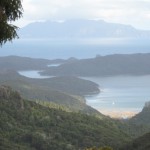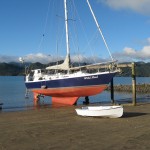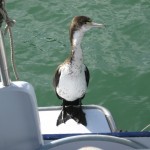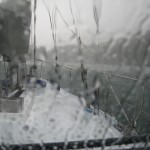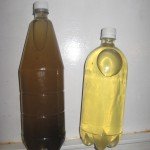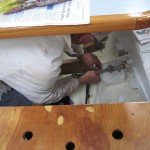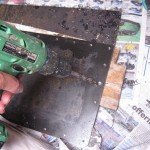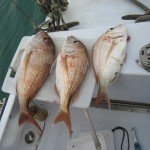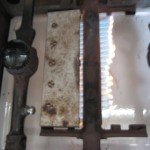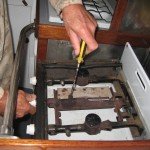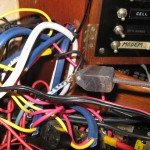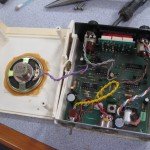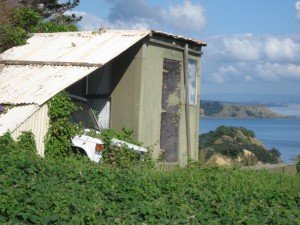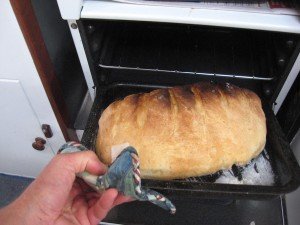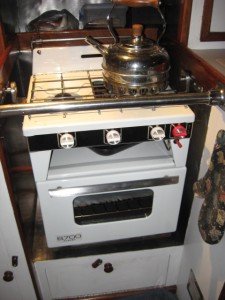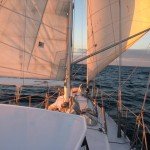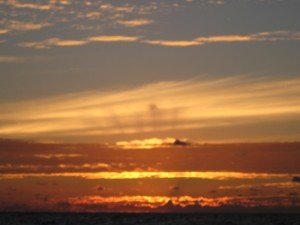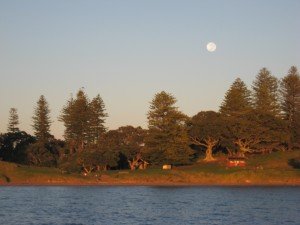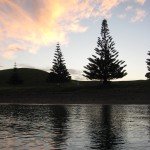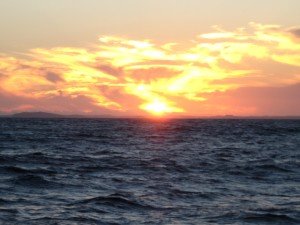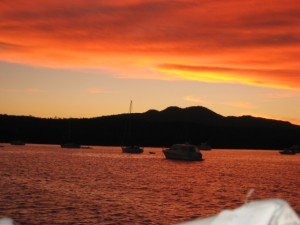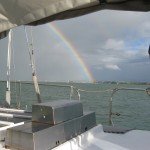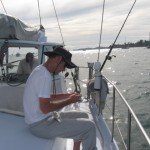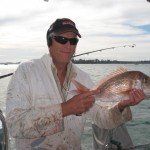Escapades Fitzroy Harbour Great Barrier Island.
Smoking Fish.
There was a run on fishing until early June when they stopped biting. Breakfast routine would have the rod set out the back on bait runner mode and a bit of kahawhai on the hook. Dusk another good time. A buzzing reel and I was assured of dinner. I kid you not, but the Admiral pleaded me to stop fishing so we could have a variation in our saturation fish diet. Talk about the Israeli fish diet. The oily kahawhai was sent to the bait jar for reincarnation (or ingestion by) into snapper. Bait fish was cut into pieces, dried in sun for several hours then cut and put in jar with plenty of salt.
Smoking in Smokehouse Bay was our favourite and offered a real difference in fish taste. No denying this. The fish was slit in two then salted to drive some moisture out. After an hour the fish was washed of salt, dried then the flesh was rubbed in brown sugar. Of course, we had available to us, the best three fish smokers in the world. A small fire cooked the flesh, with skin down, before it was then flipped on the rack so that the flesh faced down and could dry in a lengthy smoking, preferably overnight. We don’t normally hang a big fish as we are likely to arrive in the morning and find it incinerated in the fire. The brown sugar is optional, but I like the caramelly flavour and enhanced brown colour. The salting can be left so it preserves the flesh for longer, and also intensifies the flavour. Can you imagine our delight to wake up and row in shore to inspect the night’s smoking? A collection of golden, richly flavoured golden brown fish that would keep for the next week. (Ha ha fat chance after tasting the flesh.) Also, we tried smoking some snapper, but these were not so good as the oily type fish. Great Omega 3’s for our arthritis either way eh?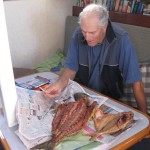
These days Webster’s Wonderland was better than usual with the facilities renewed several years ago after a slip. The bath is in a modern hut and the wetback is efficient. Over the 5 weeks we loitered around the area, and at different times we met a dozen or so boats doing the same thing. Met some nice people. I have heard that it is a completely different story in the height of summer when the bay is carpeted with hundreds of boats and one can almost walk ashore on their decks.
Telecom mobile reception.
Funny, but in 1978 when we first stumbled upon Smokehouse, if you said that we could speak to anyone in the world on a tiny piece of electronics from the boat we would think you mad. Well, of course it came to pass. Telecom’s repeater on Kaikoura Island (it stands like a silent sentinel looking over frustrated Telecom customers, providing emergency traffic only) was not operational all winter, so we hiked up the top of the hill for emails and phone calls, courtesy of the mainland transmitters 30 miles distance. Next time we will be operating 2° or Vodaphone as Telecom obviously deem dividends for shareholders more important than customer satisfaction. The spin off was that we had good exercise on the walk. The site for reception had to have line of sight with the mainland. Got some great views during conversations with friends and family. One climb with Jennifer of Doc from Abel Tasman during her kayak journey with friends. Hearsay had it that Telecom maintained the repeater only in summer.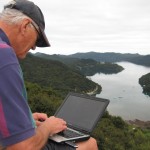
Climb Mt Hobson, Great Barrier Island.
Doc has put some great effort into this crown walk of Barrier. Now, three fords of stream are avoided by big new swing bridge, so that no more do we have to remove boots three times (yes, we are woosie trampers). Many other board walks and bridges on way to the kauri dams and summit now. No more rope rock climbs like we did over 30 years ago. (Yikes!) Virtually steps all the way to top now, partly to protect nesting birds and also the Kauri trees which in the same time have grown magnificently.
Wild Bird dries out on piles at Smokehouse.
We had to do a bottom, prop and bilge inspection so one perfect winter day we set Wild Bird aground on the Smokehouse Bay grid.
Shag mistakes duck board for shag board. This cormorant (King Shag) was very tame. We had a flock of nesting shags only 30 m away, and were woken by their raucous screeching. In Waiheke Is, we had a likewise curious duck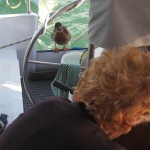 checking out Marion washing our clothes.
checking out Marion washing our clothes.
Communal hair cut. We had just finished cutting each other’s hair when a cheeky Australian sailor sat down to have his hair cut. Paid in kind by NZ Herald next day ( a copy thereof). Now that’s green dollars.
Rain reported to have fallen at Great Barrier. Er hem. It has, like the Aucklanders are fond of saying, been known to rain here. Warm and wet as the farmers are commenting about this winter. Well, we do make great cups of tea these days. We block the scuppers of the gunwales (to you nautical luddites or maritime ignoramuses, that means blocking run-off of the rainwater) so it fills our water tank. The dodger top is a rain catcher too, so we are never short of sweet water. We sterilize it by adding a capful of Janola Bleach to each 400 litres tank. The proper rate is about 10 drops per 5 litres, best left for several hours. We did this all around world when taking on dodgy water, and we never had any trouble. Pics of Spirit of NZ and NZ navy.
Patrolling of coastline. We have been investigated by NZ customs on regular reconnoitering of coastline bays half a dozen times. They are very vigilant and seem to be interested in voyaging-capable type boats like Wild Bird. Once in Picton in heavy rain. Fly-over by Orion 80 miles off Auckland, once in Fitzroy Harbour. Fisheries often travel with them. In large black RIB all decked out in helmets, heavy uniform and gear. Looks like they would be able to intercept a determined P smuggler or people smuggler. A bit like an overseas Swat team that you would see on TV thriller series. Yes we were thrilled to see them. Great to see our tax money hard at work. A bit different to the old wooden Fairmiles that we used to see cruising the coastline over thirty years ago. We must be a richer country now.
Current projects. We keep busy cooking all sorts of culinary delights coming out of our ‘new’ oven. I have made a bait board, finished just as the fish stopped baiting. It is bolted to the back railing to deflect the slaughtering products off the back. No fish has had the pleasure of being operated upon this board yet. I am presently building a new bulkhead extension to take a larger fuse board. The old one always was too small, and it was difficult to work on. I am routing 10mm rebate on the old bulkhead then ditto on the new bit, then gluing them together. I’ll purchase a BEP board some time and install it.
Fridge does bung.
An ominous electrical smell was the start of the problem. Six months ago I installed a Waeco fridge in our well insulated fridge compartment. It has worked a dream. However, the sender of the physical temperature sensor (it is a pressure sensor detecting the temperature by working a diaphragm in the control switch) broke. I had it routed through the electrical panel, and in my excitement to finish the job, I had neglected to ensure it was not in contact with wiring. A short later (melted the sender tube) and I was in the rotten food department. A bit of noodling and I discovered that a switch to short the temperature dial would enable me to manually turn on the fridge. OK, where can I purchase a 12 volt thermostat or a replacement temperature sender?


